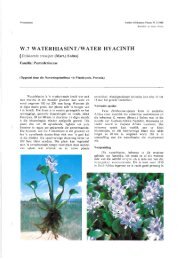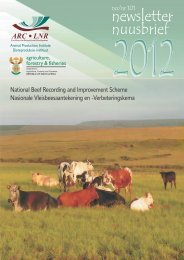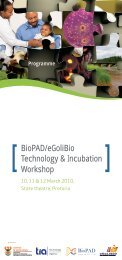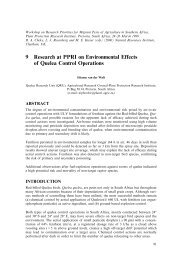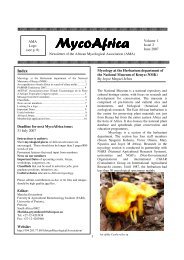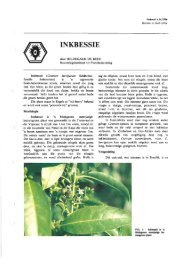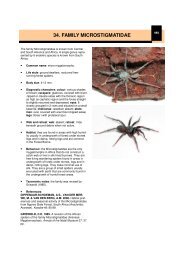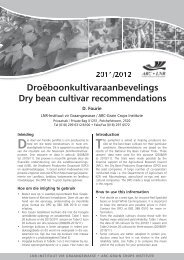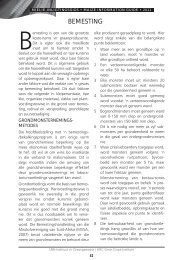View - Scorpions of Southern Africa
View - Scorpions of Southern Africa
View - Scorpions of Southern Africa
Create successful ePaper yourself
Turn your PDF publications into a flip-book with our unique Google optimized e-Paper software.
DECEMBER 2007<br />
SANSA - Newsletter<br />
No 4<br />
This publication is available from:<br />
Ansie Dippenaar-Schoeman<br />
DippenaarA@arc.agric.za or at<br />
www.arc.agric.za/home.asp?pid=3732<br />
Newsletter Newsletter Newsletter Newsletter Newsletter<br />
South <strong>Africa</strong>n National<br />
Survey <strong>of</strong> Arachnida<br />
This is the newsletter <strong>of</strong> the South <strong>Africa</strong>n National Survey<br />
<strong>of</strong> Arachnida (SANSA). SANSA is an umbrella project<br />
dedicated to unify and strengthen biodiversity research on<br />
Arachnida in South <strong>Africa</strong> and to make an inventory <strong>of</strong> our<br />
arachn<strong>of</strong>auna. It runs on a national basis in collaboration<br />
with other researchers and institutions with an interest in<br />
the fauna <strong>of</strong> South <strong>Africa</strong>.<br />
<strong>Africa</strong>n Arachnological Colloquium<br />
The <strong>Africa</strong>n Arachnological Society is organizing<br />
the 9th <strong>Africa</strong>n Arachnological Colloquium at the<br />
Lajuma Mountain Retreat. The venue is situated<br />
on the highest point <strong>of</strong> the Zoutpansberg (malaria<br />
free).<br />
It is being jointly organized by the University <strong>of</strong><br />
Venda and the ARC-Plant Protection<br />
Research Institute.<br />
Colloquium updates will be posted on the <strong>of</strong>ficial<br />
website http://soutpansberg.com/aac9<br />
Editors:<br />
Ansie Dippenaar-<br />
Schoeman & Charles<br />
Haddad<br />
Editorial committee:<br />
Almie van den Berg,<br />
Annette van den Berg &<br />
Elsa van Niekerk<br />
The deadline for payment <strong>of</strong> registration and<br />
submission <strong>of</strong> abstracts is<br />
5 January 2008.<br />
REGISTRATION FEES<br />
The registration fee is set at R350. This will include<br />
a welcoming function (Sunday evening)<br />
and copies <strong>of</strong> the program and abstracts<br />
Extra - colloquium dinner: Thursday<br />
evening, 7 February, at R70 per person – also<br />
payable with registration fee.<br />
Interested persons can contact: Dr Stefan<br />
Foord (SFoord@univen.ac.za) or<br />
Dr Ansie Dippenaar-Schoeman<br />
(DippenaarA@arc.agric.za)<br />
READ MORE ABOUT LAJUMA<br />
at www.lajuma.com<br />
If you want to know more about the fauna and<br />
flora the following information available:<br />
A First Synthesis <strong>of</strong> the Environmental, Biology<br />
and Cultural Assets <strong>of</strong> the Soutpansberg. Berger<br />
K., Crafford J.E., Gaigher I., Gaigher M.J., Hahn<br />
N., and Macdonald I., (eds). Louis Trichardt,<br />
Leach Printers and Soutpansberg, Limpopo Biosphere<br />
Initiative available on-line at http://<br />
www.soutpansberg.com/workshop/synthesis/<br />
spiders.<br />
The Colloquium will also be attended by a<br />
group <strong>of</strong> international scientists (11) from<br />
participating in the PBI Oonopidae project. A<br />
team from Belgium under leadership <strong>of</strong> Rudy<br />
Jocqué will demonstrate the fogging <strong>of</strong> tree<br />
canopies directly after the colloquium.
The virtual museum is growing rapidly and the photographs<br />
<strong>of</strong> 58 photographers have already been entered<br />
into the database totaling 250 entries (about<br />
500 images), while >100 are still waiting to be entered.<br />
Please visit the site www.arc.agric.za (quick link<br />
SANSA, virtual museum). Presently you can search<br />
by photographer or common name and species name<br />
<strong>of</strong> spider. We will improve the website’s capabilities in<br />
2008 so that a search can be done on the families<br />
and genera as well.<br />
Not all spiders can be identified to species level due<br />
to the importance <strong>of</strong> the genitalia in species identification,<br />
but with the more common species a specific<br />
identification can be given.<br />
If possible, the photographers must try to capture the<br />
specimens as well, to confirm the species identification,<br />
especially when it is a rare specimen. We make<br />
use <strong>of</strong> a team <strong>of</strong> experts to help with the identifications,<br />
and frequently we receive the answer “possibly<br />
new genus and species” from the specialists, so those<br />
specimens will be very important to collect for descriptive<br />
purposes.<br />
For more information or sending your photographs,<br />
contact Ansie Dippenaar-Schoeman at<br />
DippenaarA@arc.agric.za<br />
Bird dropping spiders <strong>of</strong> the family Thomisidae Phrynarachne<br />
spp. photographed by John R<strong>of</strong>f (top) and<br />
Jenny Cook (bottom) in KZN.<br />
SANSA - Newsletter No 4<br />
SANSA Virtual Museum<br />
A BIG THANK YOU TO: Richard Gallon,<br />
Charles Haddad, Lorenzo Prendini and Rudy<br />
Jocqué for assistance with identification <strong>of</strong> photographs.<br />
Page 2<br />
Some very interesting photographs received<br />
Spider collected and photographed by Carol Smith at<br />
Mkuzi. According to Rudy Jocqué “new genus <strong>of</strong> the<br />
Ctenidae” (tropical wolf spiders).<br />
A interesting bird dropping spider <strong>of</strong> the Araneidae<br />
collected and photographed by Allen Jones at Mpetsane<br />
Conservation Estate near Clocolan.<br />
Ansie and Allen are busy writing up the behaviour <strong>of</strong><br />
this interesting species.
Araneus legonensis was originally described from<br />
Ghana in West <strong>Africa</strong>, but as part <strong>of</strong> SANSA surveys<br />
was collected on the Soutpansberg in the Limpopo<br />
Province, and at Helsgate and Hilton in KwaZulu-<br />
Natal .<br />
Abdominal pattern <strong>of</strong> Araneus legonensis.<br />
Code: b=black; w=white; y=yellow<br />
(from Grassh<strong>of</strong>f & Edmunds 1979).<br />
FURTHER READING<br />
Grassh<strong>of</strong>f, M. & Edmunds, J. 1979. Araneus<br />
legonensis n.sp. (Araneidae: Araneae) from<br />
Ghana, West <strong>Africa</strong>, and its free sector web .<br />
Bulletin <strong>of</strong> the British Arachnological Society 4:<br />
303-309.<br />
SANSA - Newsletter No 4<br />
SANSA Virtual Museum (continued)<br />
Some more interesting photographs received<br />
John R<strong>of</strong>f photographed this interesting spider at Hilton in KwaZulu-<br />
Natal. It is a spider described by Grassh<strong>of</strong>f & Edmunds (1979) as<br />
Araneus legonensis <strong>of</strong> the family Araneidae. The markings on the<br />
abdomen are very unusual, and when the spider is in it’s retreat it<br />
resembles the eye patterns <strong>of</strong> certain salticid genera (e.g. Thyene).<br />
The orb-web <strong>of</strong> Araneus legonensis<br />
(from Grassh<strong>of</strong>f & Edmunds 1979).<br />
Page 3
DO YOU WANT TO KNOW MORE ABOUT<br />
AFRICAN SPIDERS?<br />
rica.<br />
The ARC-Plant Protection Research<br />
Institute and the Koninklijk<br />
Museum voor Midden-Afrika, Belgium<br />
launched the <strong>Africa</strong>n Arachnida<br />
Database (AFRAD) in 1995,<br />
in accordance with the International<br />
Convention on Biological<br />
Diversity. AFRAD is an umbrella<br />
project dedicated to the unification<br />
and enhancement <strong>of</strong> biosystematics<br />
research on Arachnida in Af-<br />
The main aim <strong>of</strong> AFRAD is to make an inventory <strong>of</strong> the Arachnida<br />
fauna <strong>of</strong> <strong>Africa</strong> that will provide essential baseline information<br />
needed to address issues such as conservation and sustainable<br />
use. A database developed by the ITC team at ARC Central Office<br />
enables the compilation <strong>of</strong> information on the <strong>Africa</strong>n Arachnida.<br />
At the end <strong>of</strong> July 2007 the first phase <strong>of</strong> the AFRAD database<br />
went live on the ARC website. This is one <strong>of</strong> the first efforts to<br />
make ARC-databases available online. The second phase to be<br />
launched soon, will provide information on more than 600 spider<br />
genera.<br />
The AFRAD expert system is available online on the ARC web<br />
site (www.arc.agric.za see quick link AFRAD). AFRAD has provided<br />
a remarkable stimulus to Arachnid research in <strong>Africa</strong> since<br />
the launch <strong>of</strong> the project. Several projects have already been<br />
completed or are in progress. The identification tools will make an<br />
important contribution to bypass the present taxonomic impediment.<br />
THE FOLLOWING FACT SHEETS NOW<br />
AVAILABLE<br />
Data on all 72 <strong>Africa</strong>n spider families can be printed<br />
out as fact sheets include information on:<br />
• Diagnostic and descriptive characters<br />
• Behaviour<br />
• Distribution<br />
• List <strong>of</strong> genera and species with information on their<br />
distribution in <strong>Africa</strong><br />
• Information on research activities.<br />
• The information is richly illustrated with black and<br />
white line drawings, as well as colour photographs<br />
Contact: Dr Ansie Dippenaar -Schoeman at<br />
DippenaarA@arc.agric.za or Rudy Jocqué at<br />
rudy.jocque@africamuseum.be if you want to participate.<br />
Visit www.arc.agric.za see quick link AFRAD (Fact sheet)<br />
SANSA - Newsletter No 4<br />
SANSA Website<br />
For more information on SANSA visit the website<br />
www.arc.agric.za quick link SANSA<br />
Another interesting photograph<br />
Page 4<br />
TOTALS TO DATE<br />
• Number <strong>of</strong> entries in National Collection <strong>of</strong><br />
Arachnida = 30 000<br />
• Number in SANSA database (published records)<br />
= 9900<br />
This very interesting wolf spider was photographed by Hannes<br />
Mitchell at the Vaaldam. This species is known from Mozambique<br />
and this is our first record from South <strong>Africa</strong>.
SANSA - Newsletter No 4<br />
The Free State team<br />
Arachnid researchers in the Free State (clockwise from top left): Charles Haddad (University <strong>of</strong> the Free State), Leon<br />
Lotz and Trudie Peyper (National Museum), Robin Lyle and René Fourie (U.F.S.), and Allen Jones (Clocolan).<br />
SURVEY OF THE BOTANICAL GARDEN– BLOEMFONTEIN<br />
In January 2006 a project was launched jointly by the Departments <strong>of</strong><br />
Arachnology (Leon Lotz and Trudie Peyper) and Entomology (Riana<br />
Poller and Sonnika Otto) <strong>of</strong> the National Museum, to survey the<br />
Arachnida and insects <strong>of</strong> the National Botanical Gardens in Bloemfontein.<br />
From January 2006 to January 2007 pitfall traps were set to<br />
collect the surface active fauna. During 2007 sweeping and beating<br />
SPIDERS OF THE ERFENIS DAM NATURE RESERVE<br />
Since September 2005 a survey has been continuing on the arachnid<br />
fauna <strong>of</strong> the Erfenis Dam Nature Reserve near Theunissen. Initially,<br />
the project aimed to assess the impact <strong>of</strong> controlled burning on the<br />
ground-dwelling arachnid fauna (Charles Haddad), but the opportunity<br />
was taken to investigate the spider faunas <strong>of</strong> three common tree<br />
species (René Fourie and Anel Grobler) and also the spider commu-<br />
ARACHNID SYSTEMATICS<br />
Leon Lotz recently completed the study <strong>of</strong> the Afrotropical Cheiracanthium<br />
species with a revision <strong>of</strong> the described species (Lotz 2007)<br />
and publication <strong>of</strong> a separate paper in which new species from the<br />
region were described (Lotz in press). Robin Lyle is continuing her<br />
revision <strong>of</strong> the Afrotropical tracheline sac spiders. The revision <strong>of</strong><br />
Cetonana is nearing completion and the revision <strong>of</strong> Trachelas should<br />
CAPTURING THE FREE STATE ARACHNIDS WITH PHOTOGRAPHS<br />
Allen Jones is slowly but steadily building up a set <strong>of</strong> spider photographs<br />
<strong>of</strong> the Free State. He has already taken more than 700 photo-<br />
Page 5<br />
<strong>of</strong> the grass, shrub and tree species will be carried out to<br />
determine the associated fauna. The material collected so<br />
far still has to be sorted and identified. Material <strong>of</strong> a new<br />
genus <strong>of</strong> tracheline sac spiders, first caught at Erfenis Dam<br />
Nature Reserve, was also recently collected in the Botanical<br />
Gardens at the base <strong>of</strong> grass tussocks.<br />
nities in four contrasting grassland types in the reserve<br />
(René Fourie). The latter studies were completed during<br />
August 2007 and will be submitted for publication during<br />
2008. In total, 54 species were collected from the three tree<br />
species and 84 species from the grassland. Pitfall material<br />
from the fire study will be sorted during 2008.<br />
be completed by March 2008. Many new species will be<br />
described from both genera. Charles Haddad continues with<br />
revisions <strong>of</strong> various corinnid genera. The revision <strong>of</strong> Austrophaea<br />
will be published soon (Haddad in press), and the<br />
revisions <strong>of</strong> Cambalida, Messapus and Austrachelas are<br />
nearly complete. René Fourie will start her M.Sc. during<br />
2008 and will revise the genus Clubiona in southern <strong>Africa</strong>.<br />
graphs. Many <strong>of</strong> them are already displayed in the virtual<br />
museum.
SANSA - Newsletter No 4<br />
NEWS FLASHES ON SANSA SURVEYS<br />
KZN-TEMBE ELEPHANT PARK<br />
Tembe Elephant Park is situated in northern KwaZulu-Natal and<br />
borders with Mozambique to the north. Several surveys have<br />
been undertaken in Tembe since 2000 and material collected by<br />
students <strong>of</strong> the University <strong>of</strong> the Free State was recently sorted<br />
and has been sent to ARC—PPRI for identification. The data<br />
generated through these surveys will complement collections<br />
done by Alet Honiball and other students during March 2003 in<br />
the reserve, and also collecting done by John and Astri Leroy.<br />
The first paper on Tembe has been completed (see below) and<br />
once the identifications have been completed a checklist <strong>of</strong> the<br />
arachnid fauna <strong>of</strong> the reserve will be submitted for publication.<br />
At this point it seems that Tembe’s diversity will closely rival the<br />
431 spider species recorded from nearby Ndumo Game Reserve.<br />
HADDAD, C.R., HONIBALL, A.S., DIPPENAAR-SCHOEMAN,<br />
A.S., SLOTOW, R. & VAN RENSBURG, B.J. (under review).<br />
Spiders as indicators <strong>of</strong> elephant-induced habitat changes in<br />
endemic sand forest, Maputoland, South <strong>Africa</strong>. <strong>Africa</strong>n Zoology.<br />
Contact: Charles Haddad at<br />
HaddadCR.SCI@mail.uovs.ac.za<br />
Some spiders from KZN.<br />
KZN-ITHALA AND OPATHE GAME<br />
RESERVES<br />
During June-July 2007, students from the University <strong>of</strong> the<br />
Free State undertook a trip to various conserved areas in<br />
KwaZulu-Natal. This included visits to the Ithala and Ophathe<br />
Game Reserves, and to the Greater St Lucia Wetlands Park.<br />
Arachnids were intensively collected at all three sites, and<br />
several new species were collected at each. The data generated<br />
will make an important contribution to SANSA as both<br />
Ithala and Ophathe have not been previously sampled. More<br />
than 80 species were collected in each reserve, and gives<br />
some idea <strong>of</strong> the diversity <strong>of</strong> these two savanna reserves.<br />
During the next SANSA Phase II sampling season (2008-9) it<br />
is hoped that these two reserves can be included in the field<br />
surveys, which will make a valuable contribution to the SANSA<br />
surveys in conserved areas.<br />
Contact: Charles Haddad at<br />
HaddadCR.SCI@mail.uovs.ac.za<br />
KZN—UMKHUZE GAME RESERVE<br />
Page 6<br />
The Greater St Lucia Wetland Project conducted a field survey<br />
in the uMkhuze section <strong>of</strong> the Park from 10 July - 25 August<br />
using Operation Wallacea (www.opwall.com) volunteers, with<br />
some school children, but mostly undergraduate students, from<br />
UK universities. A variety <strong>of</strong> vertebrate and invertebrate taxa<br />
were targeted for the survey: small terrestrial mammals, bats,<br />
reptiles, frogs and birds and arachnids. Specimens were collected<br />
using pitfall traps, sweep netting and bush-beating.<br />
Twenty five buckets serving as pitfalls were set out at each <strong>of</strong><br />
the 10 trapping stations, and the collected material was gathered<br />
each morning for further sorting. Carol Smith <strong>of</strong> the Spider<br />
Club led the arachnid collecting part <strong>of</strong> the survey, and 193<br />
bottles <strong>of</strong> specimens were generated and will be identified in<br />
due course at the ARC—PPRI. The second phase started in<br />
November 2007.<br />
For more details contact Xander Combrink, Project Manager:<br />
combrinx@kznwildlife.com<br />
The team at Mkuzi.<br />
SPIDERS OF THE MPETSANE<br />
CONSERVATION ESTATE<br />
A survey is underway to determine the arachnid diversity <strong>of</strong> the<br />
Mpetsane Conservation Estate (previously known as Spitskoppen)<br />
near Clocolan in the Eastern Free State Highlands. Allen<br />
Jones and Jenny Looter the owners <strong>of</strong> the Estate , are both<br />
keen naturalists. Members <strong>of</strong> the Spider Research Centre undertook<br />
a collecting trip to the Estate to collect arachnids in<br />
March 2007. They were joined by Charles Haddad <strong>of</strong> the University<br />
<strong>of</strong> the Free State and Leon Lotz <strong>of</strong> the National Museum,<br />
Bloemfontein.<br />
A total <strong>of</strong> 400 specimens were collected represented by 30<br />
families and 113 species. Two news species—a very interesting<br />
bird dropping spider and a new Thysanina sp. (Corinnidae)<br />
have so far been collected on the estate.<br />
Presently the photo gallerycontains more than 1600 images <strong>of</strong><br />
spiders photographed by Allen Jones.<br />
Contact: Allen Jones at allen@lantic.net
BLOUBERG NATURE RESERVE<br />
SANSA - Newsletter No 4<br />
SANSA SURVEYS (CONTINUED)<br />
The first north-south transect across the Western Soutpansberg was<br />
completed in November-December 2006 by a team <strong>of</strong> nine that included<br />
students and lecturers from the University <strong>of</strong> Venda.<br />
Nine sites were set out at 200m altitudinal intervals and sampling<br />
included at least 16 one hour samples at each site spread over beating,<br />
sifting, sweepnetting, pitfall trapping and below and above the<br />
knee searching. The scorpions have been processed, thanks to Ian<br />
Engelbrecht, and included a total <strong>of</strong> 12 species and 2 endemics,<br />
Opisthothalmus lawrencei and Hadogenes soutpanbergensis. Grace<br />
Tshivhandekano, an honours student will analyse determinants <strong>of</strong><br />
turnover along this transect and include three additional taxa as part<br />
<strong>of</strong> her project report: Thomisidae, Aranaeidae and Gnaphosidae.<br />
Mulalo Muelelwa is writing up her thesis which investigated spiders<br />
as surrogate measures <strong>of</strong> biodiversity. She also looked at sampling<br />
protocols to determine diversity in the Savanna biome.<br />
Eight habitats (relative homogenous within each habitat), four <strong>of</strong><br />
which were in the Blouberg Nature Reserve and the rest on the farm<br />
Little Leigh in the interior <strong>of</strong> the Western Soutpansberg, were sampled<br />
using a standardized protocol and she has subsequently identified<br />
1953 adult spiders up to morpho-species. Planning for the 9 th<br />
<strong>Africa</strong>n Arachnological Colloquium that will be held at Lajuma in February<br />
is also well underway.<br />
Contact: Stefan Foord SFoord@univen.ac.za<br />
The Thuthuka team.<br />
POLOKWANE NATURE RESERVE<br />
Under supervision <strong>of</strong> Susan Dippenaar and Ansie Dippenaar-<br />
Schoeman two students Mokgadi Modiba and Thembile Khoza <strong>of</strong> the<br />
University <strong>of</strong> Limpopo have completed their MSc studies. They are<br />
waiting for the results. Their studies were a year long survey <strong>of</strong> the<br />
biodiversity <strong>of</strong> the spiders <strong>of</strong> six habitat types using four collecting<br />
methods in the Polokwane Nature Reserve, Limpopo Province. A<br />
total <strong>of</strong> 13 854 specimens were sampled. The first paper on the results<br />
is in press.<br />
DIPPENAAR, S., DIPPENAAR-SCHOEMAN, A. S., MODIBA, M.A.<br />
& KHOZA T.T. (in press). A checklist <strong>of</strong> spiders (Arachnida, Araneae)<br />
<strong>of</strong> the Polokwane Nature Reserve, Limpopo Province, South<br />
<strong>Africa</strong>. Koedoe<br />
NYLSVLEY NATURE RESERVE<br />
Page 7<br />
NATIONAL BOTANICAL GARDEN,<br />
PRETORIA<br />
In October 2007 a project started which was organized by<br />
Elizabeth Kassimatis (PPRI) with volunteers from the University<br />
<strong>of</strong> Pretoria and nearby schools. The aim <strong>of</strong> the survey is<br />
to compile a checklist <strong>of</strong> the arachnids <strong>of</strong> the Botanical Gardens<br />
in Pretoria using different trapping methods. This will<br />
continue over a period <strong>of</strong> one year.<br />
Contact: E. Kassimatis at KassimatisE@arc.agric.za<br />
A Saturday morning collecting with the Spider Club.<br />
A checklist <strong>of</strong> the spiders and scorpions <strong>of</strong> the Nylsvley Nature<br />
Reserve has been completed for publication. Spiders<br />
and scorpions have been collected over a period <strong>of</strong> 30.years<br />
from the Nylsvley Nature Reserve, South <strong>Africa</strong>. The spider<br />
check list contains 173 species, 132 genera from 37 families.<br />
The Thomisidae is the most diverse spider family with 34<br />
species (19.6 % <strong>of</strong> total) followed by the Salticidae with 19<br />
species (10.9 % <strong>of</strong> total) and Araneidae with 18 species<br />
(10.4 %). The majority <strong>of</strong> species (123) are wandering spiders,<br />
while 50 species build webs. The ground dwelling spiders<br />
comprise 60 species while 113 species have been collected<br />
from the plant layer. A total <strong>of</strong> 158 species are new<br />
records for the reserve and 6.5 % <strong>of</strong> the total known South<br />
<strong>Africa</strong>n spider fauna are protected in this reserve. The scorpion<br />
fauna <strong>of</strong> Nylsvley comprises five species in four genera<br />
and two families (5 % <strong>of</strong> the scorpion species recorded in<br />
South <strong>Africa</strong>).<br />
Buthidae are more diverse in the reserve, with four species<br />
and two genera represented. The scorpion fauna <strong>of</strong> the reserve<br />
also includes two fossorial species and two epigean<br />
species, representing five ecomorphotypes: semipsammophilous;<br />
pelophilous; lithophilous; corticolous and<br />
lapidicolous. As many as five additional scorpion species<br />
may be recorded if the reserve is sampled more intensively<br />
using appropriate techniques.<br />
Contact: Ansie Dippenaar-Schoeman at<br />
dippenaara@arc.agric.za or Lorenzo Prendini at<br />
Lorenzo@amnh.org
KRUGER NATIONAL PARK<br />
The first survey <strong>of</strong> the spiders <strong>of</strong> the Kruger National Park<br />
(KNP) was published in 2003 listing 152 species from 40 families,<br />
The number <strong>of</strong> known species from the KNP has increased<br />
after additional collecting by Meg Cumming , the Spider<br />
Club, Kyle Harris and a survey presently underway by<br />
researchers in the park.<br />
An updated checklist listing 259 species from 43 families will<br />
soon be available on the SANSA website. This is an increase<br />
<strong>of</strong> 107 species. About 13 % <strong>of</strong> the spider fauna <strong>of</strong> South <strong>Africa</strong><br />
is presently protected in the KNP.<br />
Contact: Ansie Dippenaar-Schoeman at<br />
DippenaarA@arc.agric.za<br />
AUGRABIES NATIONAL PARK<br />
Elton le Roux was recently appointed as a ranger in Augrabies<br />
National Park and he is busy with a survey <strong>of</strong> the arachnids in<br />
the park. The first collection <strong>of</strong> the park is presently being<br />
sorted and identified in Pretoria. With arachnids collected previously<br />
in the park 25 families <strong>of</strong> spiders is known represented<br />
by 39 species. The Solifugae is represented by 2 families and<br />
4 species. The scorpions still needs to be identified.<br />
Contact: Elton le Roux at elton@sanparks.org<br />
LIMPOPO PROVINCE-<br />
WELGEVONDEN NATURE RESERVE<br />
Welgevonden Nature Reserve is situated in the Waterberg<br />
district in the Limpopo Province. It is a declared heritage site<br />
<strong>of</strong> 33000 hectares bordering the Marekele National Park.<br />
Hanno Kilian, the reserve manager and his team is busy collecting<br />
arachnids from the reserve for SANSA. The data generated<br />
through this surveys will complement the Thuthuka<br />
Savanna Biome project and will also contributes towards the<br />
checklist <strong>of</strong> the Limpopo Province.<br />
The first collecting <strong>of</strong> > 100 specimens resulted in a checklist<br />
containing 24 families and 75 species. The survey continues.<br />
Contact: Hanno Kilian at hanno@welgevonden.org<br />
Argiope australis Nephila senegalensis<br />
SANSA - Newsletter No 4<br />
SANSA SURVEYS (CONTINUED)<br />
Page 8<br />
FIRST SURVEY OF THE ANYSBERG<br />
NATURE RESERVE<br />
During September 2007 Charles Haddad and Robin Lyle undertook<br />
a collecting trip to the Western Cape. The first collecting<br />
point was the Anysberg Nature Reserve near Laingsburg in the<br />
Karoo. Initial collecting was very successful and nearly 90 species<br />
<strong>of</strong> arachnids were collected in the reserve. Reserve Manager<br />
Collette van Deventer has shown great interest in including<br />
ANR as one <strong>of</strong> the sites for the SANSA field surveys, and Robin<br />
Lyle will include this as one <strong>of</strong> her sites in the 2008-9 season.<br />
Collette has field rangers that will assist with the field work then,<br />
but who will also be collecting material for ARC—PPRI during<br />
the coming year.<br />
During this trip additional collecting was done at the De Hoop<br />
Nature Reserve, as well as day-long collections at the Marloth<br />
Nature Reserve in Swellendam, and the Fernklo<strong>of</strong> Nature Reserve<br />
in Hermanus. Several new records <strong>of</strong> corinnid spiders<br />
were generated. Of particular importance was the collection <strong>of</strong><br />
only the third specimen <strong>of</strong> Trachelas scopulifer, at Fernklo<strong>of</strong><br />
(previously known only from the holotype and a single female<br />
from NMBA).<br />
Contact:Charles Hadda at HaddadCR.SCI@mail.uovs.ac.za<br />
SURVEY OF THE DE HOOP NATURE RE-<br />
SERVE<br />
The checklist <strong>of</strong> the De Hoop Nature Reserve was recently submitted<br />
to Koedoe for publication. A total <strong>of</strong> 275 arachnid species<br />
were recorded in this survey, with spiders the dominant group<br />
(252 species, 53 families). The study indicates that fynbos and<br />
associated habitats contain a fauna and community composition<br />
similar to more structurally complex habitats such as savanna. It<br />
is hoped that this study will form the baseline for further research<br />
on arachnids in the Fynbos Biome.<br />
Contact: Charles<br />
Haddad at<br />
Cyrtaucheniid sp.<br />
collected at De Hoop<br />
Nature Reserve.<br />
SURVEY OF THE KOGELBERG NATURE<br />
RESERVE<br />
We have received the first spiders (33 bottles) collected at the<br />
Kogelberg Nature Reserve. This reserve lies in the Western<br />
Cape, 60 km SE <strong>of</strong> Cape Town in the “heart <strong>of</strong> the fynbos”. It<br />
falls within the Kogelberg Biosphere Reserve.<br />
From the first samples 12 spider families have been identified<br />
including a trapdoor spider and specimens from the family Drymusidae<br />
that is endemic to the Western Cape.<br />
Contact: Corlie Hugo at admin@kogelbergbiosphere.co.za
CEDARBERG WILDERNESS AREA<br />
The first survey samples collected by Dr Antoinette Veldtman<br />
and her team are presently being identified in Pretoria. Rika du<br />
Plessis (manager <strong>of</strong> the Cederberg Wilderness area) is the new<br />
regional ecologist for the Boland Mountains and Cape Metro<br />
Business Units <strong>of</strong> CapeNature and she and her team are very<br />
enthusiastic to participate in SANSA and do arachnid collecting in<br />
the Western Cape. This collection will be another important contribution<br />
to determine the arachnid biodiversity <strong>of</strong> the Western<br />
Cape Province.<br />
The Cedarberg committee decided to dedicate their open day to<br />
the SANSA project and Norman Larsen presented lectures on<br />
spiders to the group.<br />
Contact: Dr Antoinette Veldtman at<br />
Antoinette@cncjnk.wcape.gov.za<br />
SURVEY OF THE TABLE MOUNTAIN NA-<br />
TIONAL PARK<br />
Norman Larsen and Ansie Dippenaar-Schoeman are busy with a<br />
checklist <strong>of</strong> the spiders <strong>of</strong> the Table Mountain National Park and<br />
the rest <strong>of</strong> the Cape Peninsula. The results are based on all published<br />
records, as well as records in the National Collection <strong>of</strong><br />
Arachnida and the Iziko Museum. At present a total <strong>of</strong> 44 families<br />
represented by 174 species has been collected.<br />
New surveys are now underway under leadership <strong>of</strong> Norman and<br />
Ruth-Mary Fisher <strong>of</strong> the SANparks. Some additional data has<br />
also been generated through a project <strong>of</strong> James Pryke, a PhD<br />
student from the University <strong>of</strong> Stellenbosch. His project title is<br />
“Conservation <strong>of</strong> the Arthropod Fauna <strong>of</strong> the Cape Peninsula”.<br />
He has been collecting a variety <strong>of</strong> invertebrates for the last<br />
two years on the Cape<br />
Peninsula, using pitfall<br />
traps, window traps,<br />
Berlese/Tulgren funnels,<br />
D-Vac sampling<br />
and both aerial and<br />
ground visual<br />
searches. About 80<br />
spider species have<br />
been collected and are<br />
being identified in Pretoria.<br />
SANSA - Newsletter No 4<br />
SANSA SURVEYS (CONTINUED)<br />
Some material from<br />
Winkler traps collected<br />
by members <strong>of</strong> the<br />
Iziko Museum is presently<br />
sorted in Pretoria.<br />
Contact: Norman<br />
Larsen at spiderboy@telkomsa.net<br />
& Ansie Dippenaar-<br />
Schoeman<br />
SPIDERS FROM CAVES<br />
Page 9<br />
An assessment <strong>of</strong> the present status <strong>of</strong> spiders (Araneae) from<br />
caves from South <strong>Africa</strong> are under way. A total <strong>of</strong> 45 species<br />
from 21 families are known from 31 cave complexes in South<br />
<strong>Africa</strong>. Of the species collected, only 11 species are regarded<br />
as true cave spiders (troglobites), while the rest are troglophiles<br />
found inside and outside cave or accidentals. This baseline<br />
information gathered here is needed to determine where<br />
surveys are still needed for the development <strong>of</strong> management<br />
strategies for conservation planning <strong>of</strong> cavernicolous spiders.<br />
This study forms part <strong>of</strong> the South <strong>Africa</strong>n National Survey <strong>of</strong><br />
Arachnida (SANSA).<br />
Contact: Ansie Dippenaar-Schoeman & Jan Myburgh at<br />
Jan.myburgh@up.ac.za<br />
Phyxelididae: Vidole capensis a spider found in caves<br />
in the Eastern Cape.<br />
SPIDERS ON CITRUS<br />
South <strong>Africa</strong> is the third largest exporter <strong>of</strong> citrus fruit in the<br />
world and steadily increasing in importance. Spiders are numerous<br />
in South <strong>Africa</strong>n orchards and form a major part <strong>of</strong> the<br />
predatory complex in citrus trees preying on a variety <strong>of</strong> arthropod<br />
pest species. With increased interest in reduced chemical<br />
control strategies, the need to understand this diverse group <strong>of</strong><br />
organisms in our agro-ecosystems is increasing. However,<br />
before farmers can consider their role in integrated pest management<br />
programmes, spiders must be collected, studied and<br />
integrated into an information system.<br />
Spiders were collected over a 25-year period from 11 sites in 5<br />
different citrus-growing areas in South <strong>Africa</strong>. In the orchards<br />
most spiders were collected by hand or with a beating tray. Data<br />
<strong>of</strong> quantitative studies undertaken in some orchards are also<br />
included. Presently 21 families represented by 135 genera and<br />
198 species have been recorded. The Thomisidae family is the<br />
richest in species numbers (28), followed by the Salticidae (24),<br />
Araneidae (23) and Theridiidae (20). Most species collected are<br />
wanderers constituting 58.2 % <strong>of</strong> the spiders found compared to<br />
the web dwellers 41.8%. This survey falls within the framework<br />
<strong>of</strong> the South <strong>Africa</strong>n National Survey <strong>of</strong> Arachnida<br />
(SANSA) <strong>of</strong> spider assemblages in agro-ecosystems.<br />
Contact: Ansie Dippenaar-Schoeman and Almie van den<br />
Berg at vdbergam@arc.agric.za
NEW THREATENED SPECIES PROGRAMME<br />
MANAGER AT SANBI<br />
Congratulations to Solly Nkoana <strong>of</strong> SANBI who has been<br />
appointed as the new Threatened Species Programme Manager,<br />
previously held by Wendy Foden. SANSA is one <strong>of</strong> the<br />
projects in this programme.<br />
RHODES UNIVERSITY<br />
An honours student Jessica Cockburn and her supervisor Pr<strong>of</strong><br />
Martin Villet at Rhodes University surveyed cave invertebrate<br />
communities to determine their composition in caves in the<br />
Eastern Cape. They hope to use the data collected to describe<br />
and catalogue the invertebrates (mostly insects and arachnids)<br />
found in these underground environments as a contribution to<br />
record biodiversity countrywide, and to contribute to the broader<br />
aims <strong>of</strong> the International Convention on Biodiversity.<br />
EFFECT OF FIRE ON SPIDERS<br />
Dr Kate Parr <strong>of</strong> the Oxford University Centre for the Environment<br />
has been awarded a grant from the Rufford Innovation to fund<br />
work on invertebrates and fires in savannas. This includes spiders!<br />
The idea is that the grant will be sufficient for a bursary for a<br />
MSc student at University <strong>of</strong> Pretoria for work in Kruger and<br />
Hluhluwe-iMfolozi park. This will be done in collaboration with Dr<br />
B. van Rensburg <strong>of</strong> University <strong>of</strong> Pretoria and ARC-PPRI.<br />
SPIDER DRAGLINE SILK<br />
Dr Anna Rising used an <strong>Africa</strong>n spider Euprosthenops australis<br />
collected in South <strong>Africa</strong> to determine the molecular properties<br />
and recombinant expression <strong>of</strong> spider dragline silk. This was for<br />
her doctoral thesis at the Faculty <strong>of</strong> Veterinary Medicine and<br />
Animal Science <strong>of</strong> the Acta Ubiversitatis Agriculturae Sueciae.<br />
Pisauridae: Euprosthenops australis<br />
Photographer: Allen Jones.<br />
SANSA - Newsletter No 4<br />
OTHER NEWS FLASHES<br />
SOME SPIDER CLUB NEWS<br />
Page 10<br />
Four illustrated talks were presented to clubs and schools.<br />
Two illustrated public talks were presented at Yebo Gogga<br />
2007, University <strong>of</strong> the Witwatersrand with the theme <strong>of</strong><br />
"Ubuntu" as well as a talk to People for Wildlife at the<br />
Kgaswane Nature Reserve, North West Province.<br />
Two Spider Club beginners' Identification Courses with Ian<br />
Engelbrecht were organized at Mellville Koppies and<br />
Klo<strong>of</strong>endal Nature Reserve.<br />
Surveys were undertaken at the Ruimsig Entomological<br />
Reserve and Lowveld National Botanical Gardens. The<br />
sorting and data extracting is still taking place.<br />
Six spider walks with talks were organized at Pretoria<br />
National Botanical Garden (2); Walter Sisulu National<br />
Botanical Garden, Roodepoort (2); Lowveld National Botanical<br />
Gardens, Nelspruit (1) and Friends <strong>of</strong> Klo<strong>of</strong>endal.<br />
A radio talk was broadcast over Jacaranda 94.2 radio.<br />
- Astri and John Leroy<br />
17TH INT. CONGRESS OF ARACHNOLOGY<br />
The 17th International Congress <strong>of</strong> Arachnology took place from<br />
5-11 August 2007 in São Pedro, Brazil. This was the first time<br />
that the International Congress was hosted by a South American<br />
country. A total <strong>of</strong> 320 delegates from 34 countries attended<br />
the congress. A total <strong>of</strong> 115 oral papers and 259 posters<br />
were presented, dealing with a variety <strong>of</strong> topics.<br />
South <strong>Africa</strong> was well represented with Ansie Dippenaar-<br />
Schoeman, Stefan Foord, Charles Haddad and Leon Lotz attending.<br />
Then there was also the “lost son” in the USA Lorenzo<br />
Prendini. Although not all from <strong>Africa</strong> a total <strong>of</strong> 21 papers and<br />
posters on <strong>Africa</strong>n arachnid fauna were presented at the congress.<br />
The South <strong>Africa</strong>n delegates: Lorenzo Prendini, Ansie<br />
Dippenaar-Schoeman, Leon Lotz, Charles Haddad and<br />
Stefan Foord.
SANSA - Newsletter No 4<br />
NEW PUBLICATIONS ON SOUTH AFRICAN SPIDERS<br />
ALDERWEIRELDT, M. & JOCQUé, R. 2007. Minicosa neptuna<br />
n. gen., n. sp. (Araneae, Lycosidae), the smallest wolf spider<br />
from <strong>Africa</strong>. Journal <strong>of</strong> Afrotropical Zoology 3: 3–9.<br />
DIPPENAAR, S., DIPPENAAR-SCHOEMAN, A. S., MODIBA,<br />
M.A. & KHOZA T.T. (in press). A checklist <strong>of</strong><br />
spiders (Arachnida, Araneae) <strong>of</strong> the Polokwane Nature Reserve,<br />
Limpopo Province, South <strong>Africa</strong>. Koedoe.<br />
DIPPENAAR-SCHOEMAN, A.S. & WASSENAAR, T. 2006. A<br />
checklist <strong>of</strong> spiders from the herbaceous layer <strong>of</strong> a coastal dune<br />
forest ecosystem at Richards Bay, KwaZulu-Natal, South <strong>Africa</strong><br />
(Arachnida: Araneae). <strong>Africa</strong>n Invertebrates 47: 63–70.<br />
FOORD, S.H., MAFADZA, M., DIPPENAAR-SCHOEMAN, A.S.,<br />
& VAN RENSBURG, B.J. (in press). Spiders and conservation in<br />
the Soutpansberg, South <strong>Africa</strong>. <strong>Africa</strong>n Zoology.<br />
FROMHAGE, L., JACOBS, K. & SCHNEIDER, J.M. 2007.<br />
Monogynous mating behaviour and its ecological basis in the<br />
Golden Orb Spider Nephila fenestrata. Ethyology 113: 813–820.<br />
HADDAD, C. R., 2006. Spinotrachelas, a new genus <strong>of</strong> tracheline<br />
sac spiders from South <strong>Africa</strong> (Araneae: Corinnidae).<br />
<strong>Africa</strong>n Invertebrates 47: 85–93.<br />
HADDAD, C.R. 2007. A new species <strong>of</strong> Corinnomma (Araneae:<br />
Corinnidae) from southern and eastern <strong>Africa</strong>, with taxonomic<br />
notes on C. olivaceum and C. semiglabrum. <strong>Africa</strong>n Invertebrates.<br />
HADDAD, C.R. 2007. A revision <strong>of</strong> the endemic South <strong>Africa</strong>n<br />
dark sac spider genus Austrophaea (Araneae: Corinnidae). <strong>Africa</strong>n<br />
Invertebrates 48: 47-53.<br />
HADDAD, C.R., HONIBALL, A.S., DIPPENAAR-SCHOEMAN,<br />
A.S., SLOTOW, R. & VAN RENSBURG, B.J. (under review).<br />
Spiders as indicators <strong>of</strong> elephant-induced habitat changes in<br />
endemic sand forest, Maputoland, South <strong>Africa</strong>. <strong>Africa</strong>n Zoology.<br />
HARRIS, K.R., VAN RENSBURG, B.J., ROBERTSON, M.P.,<br />
COETZEE, J.A. & DIPPENAAR-SCHOEMAN, A. S. (under review).<br />
How better to collect spiders (Araneae) in an plant invaded<br />
<strong>Africa</strong>n savanna using the Kruger National Park as a case study.<br />
<strong>Africa</strong>n Entomology.<br />
JOHANNESEN, J. , LUBIN, Y., SMITH, D. R.,BILDE, T. &<br />
SCHNEIDER, J. T. 2006. The age and evolution <strong>of</strong> sociality in<br />
Stegodyphus spiders: a molecular phylogenetic perspective.<br />
Proceedings <strong>of</strong> the Royal Society <strong>of</strong> London 274: 231–237.<br />
KUNTNER, M. A. 2007. A monograph <strong>of</strong> Nephilengys, the pantropical<br />
‘hermit spider’ (Araneae, Nephilinae). Systematic Entomology<br />
32: 95–135.<br />
LOTZ, L. N. 2006. Afrotropical Archaeidae: 3. The female <strong>of</strong><br />
Eriauchenius cornutus and new species <strong>of</strong> Afrarchaea<br />
(Arachnida: Araneae) from South <strong>Africa</strong>. Navorsinge van die<br />
Nasionale Museum Bloemfontein 22: 113–127.<br />
Page 11<br />
LOTZ, L. N. 2007. The genus Cheiracantium (Araneae: Miturgidae)<br />
in the Afrotropical region. 1. Revision <strong>of</strong> known species.<br />
Navorsinge van die Nasionale Museum Bloemfontein 23:<br />
1-76.<br />
LOTZ L.N. (in press). Revision <strong>of</strong> the Afrotropical genus Cheiracanthium<br />
(Araneae: Miturgidae: Eutichurinae): 2. new species.<br />
Navorsinge van die Nasionale Museum Bloemfontein.<br />
LOVELL, S., HAMER, M., SLOWTOW, R. & HERBERT, D.<br />
2007. Assessment <strong>of</strong> congruency across invertebrate taxa and<br />
taxonomic levels to identify potential surrogates. Biological Conservation<br />
139: 113–125.<br />
LYLE, R. & HADDAD, C.R. (in press). A revision <strong>of</strong> the Afrotropical<br />
tracheline sac spider genus Thysanina Simon, 1910<br />
(Araneae: Corinnidae). <strong>Africa</strong>n Invertebrates.<br />
MANDISA, P.M., SOMERS M.J. & DIPPENAAR-SCHOEMAN,<br />
A.S. (in press). Spider responses to alien plant invasion: the<br />
effect <strong>of</strong> short- and long-term Chromolaena odorata invasion<br />
and alien clearing. Journal <strong>of</strong> Applied Ecology.<br />
MURPHY, J. & RUSSEL-SMITH, A. 2007. A revision <strong>of</strong> the<br />
spider genus Echemella Strand 1906 (Araneae, Gnaphosidae).<br />
Journal <strong>of</strong> Afrotropical Zoology 3: 15-22.<br />
PLATNICK, N.I. & BIRD, T.L. 2007. On the first <strong>Africa</strong>n spiders<br />
<strong>of</strong> the subfamily Molycriinae (Araneae, Prodidomidae). American<br />
Museum Novitates 3552: 1–8.<br />
PLATNICK, N. I. & UBICK, D., 2007. A revision <strong>of</strong> the spider<br />
genus Zoroctrates Simon (Araneae, Zorocratidae). American<br />
Museum <strong>of</strong> Natural History 3579:1-44.<br />
RUSSELL-SMITH, A., ALDERWEIRELDT, M. & JOCQUé,<br />
R., 2006. On the new genus Foveosa accommodating the Afrotropical<br />
wolf spiders related to Pardosa foveolata (Araneae:<br />
Lycosidae). Journal <strong>of</strong> Afrotropical Zoology 3: 59–76.<br />
UYS, C. HAMER, M. & SLOWTOW, R. 2007. Effect <strong>of</strong> burn<br />
area on invertebrate recolonization in grasslands in the Drakensberg,<br />
South <strong>Africa</strong>. <strong>Africa</strong>n Zoology 41: 51–65.<br />
WESOLOWSKA, W., 2006. A new species <strong>of</strong> Cyrba from South<br />
<strong>Africa</strong> (Araneae: Salticidae: Sparteinae). Genus 17(4): 617-620.<br />
WESOLOWSKA, W., 2006. A new genus <strong>of</strong> ant-mimicking Salticid<br />
spider from <strong>Africa</strong> (Araneae: Salticidae: Leptorchestinae).<br />
Annales Zoologici 56: 435-439.<br />
NEW COFFIE TABLE BOOK<br />
“Hidden wonders— the small 5005 <strong>of</strong><br />
southern <strong>Africa</strong>n insects, spiders, frogs,<br />
reptiles”<br />
Text by Rael Loon and photographs by Dan<br />
Lieberman. Jacana Media (Pty) Ltd 2007,<br />
Auckland Park South <strong>Africa</strong>. For more information<br />
visit www.jacana.co.za
SANSA - Newsletter No 4<br />
PUBLIC PARTICIPANTS IN SANSA SURVEYS<br />
We were very surprised with the response from the public to collect<br />
spiders for the SANSA project. We are busy sorting and identifying all the<br />
material that we have received here in Pretoria.<br />
In the next newsletter we’ll provide some more information on specimens<br />
received such as:<br />
Jeffreysbay (Linda Wiese)<br />
Gouritzriver Mouth (Helen Leibel)<br />
Hermanus (Victor Hamilton-Atwell)<br />
Strand (S. Horn )<br />
Moos River Valley ( Sonja Martens)<br />
Kommetjie (Swannie)<br />
Gauteng (Warren Smidth)<br />
Free State—Clocolan and others (Allen Jones)<br />
Best wishes for 2008!<br />
This is how Allen Jones predicts the year to come.<br />
Page 12




